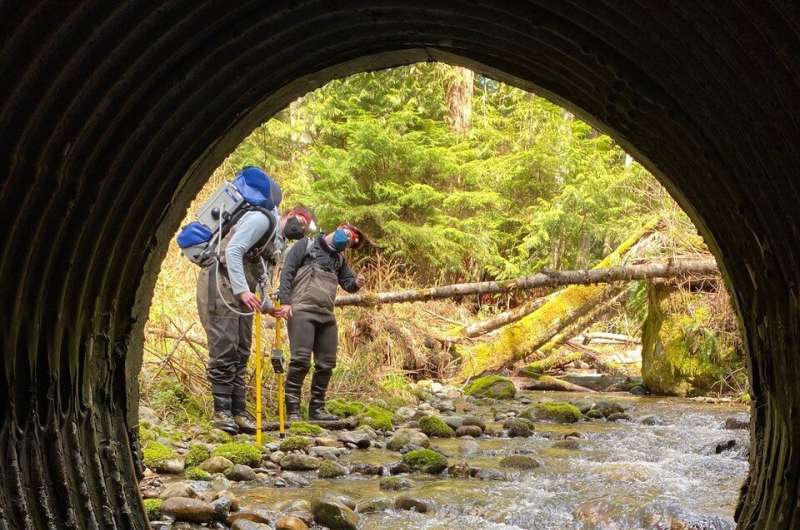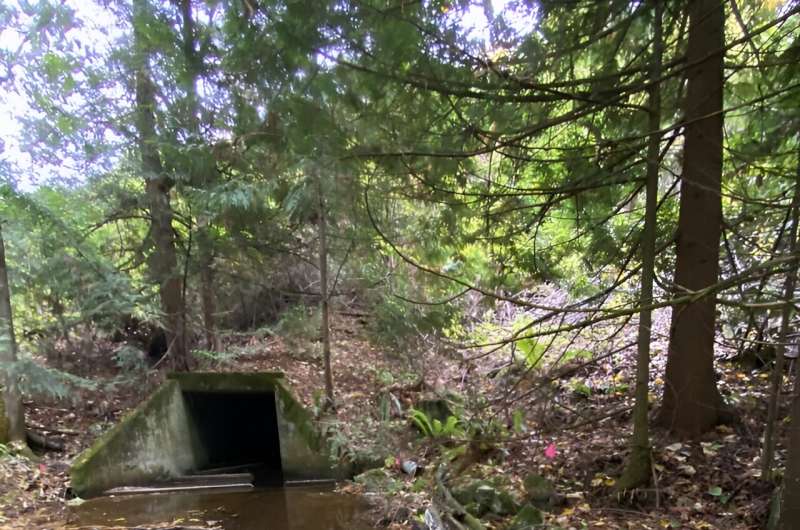This article has been reviewed according to Science X's editorial process and policies. Editors have highlighted the following attributes while ensuring the content's credibility:
fact-checked
peer-reviewed publication
trusted source
proofread
DNA shows where Washington culvert replacements helped spawning salmon

To help struggling salmon populations, the state of Washington is legally required to replace hundreds of culverts that divert streams under roadways. The state transportation department is replacing old, rusting metal pipes with broad, concrete promenades that provide more gradual gradients and gentler flows for salmon swimming upstream to access more spawning grounds. The full scope of the effort will last 17 years and cost $3.8 billion.
But how successful are these projects at boosting fish traffic? A team from the University of Washington and the National Oceanic and Atmospheric Administration performed genetic sleuthing during two culvert replacements in 2021–22 near the city of Bellingham. Post-intervention monitoring shows that upgrading one culvert—which went under Interstate-5—had a big impact, and the other culvert may not have been as much of a barrier. Construction did not disrupt fish populations at either site.
The study is published in Ecological Applications.
"This was an amazing study to work on, both in terms of the science and the broader implications. We demonstrated that we can measure the impact of management interventions using only DNA recovered from the water," said lead author Elizabeth (Eily) Andruszkiewicz Allan, who began the project as a UW postdoctoral researcher in marine and environmental affairs and is now chief scientist at the UW-based eDNA Collaborative.
For the study, the researchers didn't catch or count a single fish. Instead, from March 2021 to December 2022—before, during and after the project—they collected water samples each month at locations just upstream and downstream of the culvert. Back in the lab, they sequenced the fragments of floating DNA to identify the type and amount of DNA of salmonid species present.
The study used a new type of monitoring known as "environmental DNA," or eDNA. Fragments of DNA floating in the environment on scales, scat, fur or other material can help researchers detect which species are nearby, rather than relying on visual counts, cameras or traps.
A fish's DNA stays in the water for a day or two. The researchers aimed to use the culvert project as a model for the use of eDNA in environmental impact reporting, more generally.

The study focused on two construction projects along Padden Creek, a roughly 3-mile creek flowing from Padden Lake to Bellingham Bay. One culvert replacement was a major upgrade under I-5. DNA results show improvement for the four species of interest: cutthroat trout, coho salmon, rainbow trout and sockeye salmon. The other project, a smaller culvert replacement under state Route 11, or Old Fairhaven Parkway, had less impact: Trout and salmon DNA were present at similar levels before and after construction, meaning the older culvert may have been passable to fish.
"It is clear that not all things that are marked as a blockage to salmon are, in fact, blockages to salmon," Allan said. "In the future, DNA sampling upstream of culverts might be something to add to the prioritization process."
The results could help support ongoing efforts to replace culverts across the West Coast and in Alaska.
"Environmental DNA offers a pretty different way of seeing the world," said co-lead author Ryan Kelly, a UW professor of marine and environmental affairs. "We can see thousands of species in a liter of water, in a way that no other sampling method can. And what makes eDNA really attractive is it's easily repeatable and scalable."
Researchers collected water samples using a high-tech backpack donated by Smith-Root, a company based in Vancouver, Washington. They sequenced about 52 million fragments of DNA in total, about half of which were for the four salmonid species of interest.
Researchers also surveyed five other creeks as controls. In the future, the authors say, engineers or surveyors could collect water samples for environmental monitoring more easily than surveying and identifying fish, making it simpler to combine with other measurements.
"If you had to go out there with another method and find and count fish, it would take all day," Kelly said. "So eDNA offers a real savings in terms of in terms of time and effort in the field."
More information: Elizabeth Andruszkiewicz Allan et al, Quantifying impacts of an environmental intervention using environmental DNA, Ecological Applications (2023). DOI: 10.1002/eap.2914
Journal information: Ecological Applications
Provided by University of Washington

















